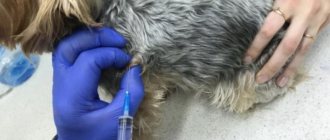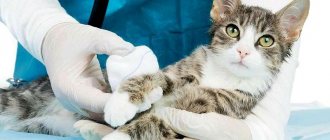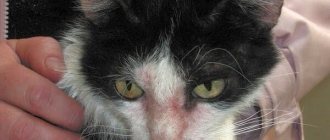Various wounds and other damage to the skin are the most common reason for a cat owner to contact a veterinarian. Naturally curious and active animals, they constantly expose themselves to the risks of injury.
Wounds in domestic cats are not a rare occurrence and all owners of mustachioed pets have encountered it. The cause of a wound in a cat can be damage in everyday life, fights with relatives or yard dogs.
Much will depend on the origin of the wound, its size and depth, as well as the possibility of introducing pathogenic microflora into it. In particular, a veterinary specialist, based on the results of the clinical picture and laboratory tests, prescribes an adequate therapeutic course, which, in turn, will prevent serious complications associated with a cat’s wound that is not treated in a timely manner.
What to look for
Fresh wounds usually appear partially or completely:
- Bleeding
- Swelling
- Lack of hair
- Cut, scratched or torn skin
- Lame
- Tenderness or pain
If a fresh wound is not visible, it may become infected.
In addition to swelling and soreness, you may experience the following:
- Discharge (pus) from the wound
- Abscesses (that is, a collection of pus under the skin) and the resulting hole in the skin when the abscess is opened and drained.
- Signs of a fever (such as lethargy and ears that feel hot to the touch)
What are the types of ulcers?
The main types of skin ulcerative lesions are shown in the table:
| Variety | Peculiarities |
| Simple | Heals quickly, leaving a scar |
| Bacterial | Characterized by the appearance of pus, does not heal well |
| Edema | Covered with a granulation structure that can be easily destroyed with a finger |
| Decubital (bedsore) | Develops due to impaired blood flow due to prolonged immobility of the animal |
| Gangrenous | Characterized by necrosis of areas of the skin of the abdomen |
| Can be dry or wet | |
| Neurotrophic | Occurs due to nerve damage or malnutrition of central nervous system tissues |
First aid
What you can do at home ultimately depends on your cat. Sometimes the only thing you can do is wrap your cat in a towel or put him in a carrier and take him straight to the vet.
However, there are a few things you can do if your cat will let you, especially if it will be a while before you can get to the vet.
If there is bleeding, apply pressure to the wound. Cover the wound with sterile gauze or a clean cloth and apply pressure. It may take 5–10 minutes for the bleeding to stop.
Once this happens, secure the gauze with tape; removing it may remove the clot and bleeding will resume.
Check for other wounds.
If there is no bleeding and the cut (tear) or scrape (abrasion) appears minor, try cleaning the wound.
Use an antiseptic solution or plain water and gauze or cloth (not cotton) to gently clean the area around the wound, and a syringe or similar device to flush the solution over the surface of the wound.
Antiseptic solutions are prepared by diluting store-bought concentrated solutions containing either povidone iodine or chlorhexidine diacetate as the active ingredient.
Do not use alcohol or hydrogen peroxide on wounds as they may damage tissue. Povidone should be diluted to the color of weak tea; Chlorhexidine should be diluted to a pale blue color.
If the wound is long or deep , or if it is a puncture wound, you can clean the edges as already described, but do not clean the wound itself. Let the vet do it.
Once you have done everything possible, take your cat to the vet.
Possible complications
As we have already found out, if you do not treat your pet in a timely manner, pathogenic bacteria can penetrate into the wound and suppuration will begin to develop in it. If the wound is closed, then pus accumulates inside and an abscess appears. Such replenishment cannot be cured at home with the help of an antiseptic and bandages, so the treatment process is best entrusted to an experienced veterinarian. He will be able to assess the extent of the inflammation and choose the appropriate treatment strategy for your cat.
Complications can also arise if the wound is not completely treated. This can happen if the owners, for example, stop giving the cat medications without completing the course of treatment to the end. At first, it will seem that the pet is absolutely healthy and has finally returned to normal life. But in fact, inflammatory processes will still take place inside his body, which will slowly spread throughout the body. This will affect the general physical condition of the pet, as well as all its internal organs. The immune system will be weak, which means the cat will be highly susceptible to all kinds of viruses and diseases. Thus, if the wound is not completely treated in a timely manner, this will lead to the emergence of new, more dangerous diseases.
Veterinary assistance
Diagnostics
Your veterinarian will carefully examine your cat and evaluate any wounds found. Your cat will also be examined for other problems.
For proper assessment, the cat's fur must be shaved. Some wounds may require x-rays. The examination may also require sedation.
Treatment of wounds in cats
The main goals of treatment are to prevent infection and promote healing. Different types of wounds require different methods to achieve these goals.
In most cases, your cat will need sedation or anesthesia to ensure the wounds are treated safely and without causing further pain.
-Minor scrapes and cuts often require nothing more than a thorough cleaning and perhaps a little leather glue to hold the edges of the cut together.
- Long and/or deep cuts require careful cleaning to ensure there is no debris in the wound and careful examination to determine the extent of the damage. If the wound is less than 12 hours old and not heavily soiled, it will probably be closed with a closed suture.
— Puncture wounds, especially from animal bites, often have extensive damage under the skin that is not visible upon initial examination. After removing any possible foreign material, these wounds should be carefully examined and then thoroughly washed with copious amounts of antiseptic solution. Sometimes these wounds need to be opened surgically to treat deep tissue damage.
— Meanwhile, puncture wounds and/or wounds older than 12 hours that are contaminated or have signs of infection, abscesses, or large areas of skin missing are usually not sutured. Instead, they are covered with bandages until the wound has healed or the wound is healthy enough for the stitches to actually help the wound rather than trap the infection inside.
- Large or deep wounds, contaminated wounds or multiple puncture wounds often require the placement of a Penrose drain, which is a soft rubber tube that allows excess contaminated tissue fluid to drain out and leaves a small opening for flushing antiseptic solution through the wound. .
Your veterinarian will prescribe medication for your cat for infection and possibly pain, which you will need to continue to give at home.
Most cats are released within 24 hours of admission.
The diet of a cat with purulent wounds also affects the treatment of purulent wounds in cats
A cat with festering wounds is very sensitive
.
All smoked meats, sausages, sweets that should not be given to even healthy cats, and fatty meats should be removed from the diet. A festering wound will heal faster if you eat healthy, natural foods, for example, vegetables, boiled chicken, and fish. Remember healthy, dietary food in hospitals and sanatoriums. You will never find sausage or unhealthy smoked brisket there. During the period of active recovery, it is very advisable to give your pet synthetic vitamins that will help maintain the health of the furry.
Caring for a sick cat
The most important thing you can do when your cat comes home is to make sure she is well cared for. Fortunately, this usually takes 1-2 weeks. Good nursing care includes:
— Do not allow your cat to lick, chew, or scratch wounds, stitches, dressings, or drains. This may require the use of an Elizabethan collar.
- Keep dressings clean and dry and change them as directed by your veterinarian. Initially this may be 2-3 times a day. You may need to take your cat to the vet for changes, especially if he is uncooperative. If the bandages become wet, or you notice an odor, chafing, or increased drainage (or the drainage does not subside), take your cat to the veterinarian for an examination.
— Apply a thin layer of antibiotic ointment to the edges of the wound once or twice a day, but only if the cat cannot lick it off.
— Make sure your cat is receiving all of its prescribed medications. If you have problems administering it, contact your veterinarian.
If the wounds are not serious or complications do not develop, here is a typical schedule of activities after visiting the veterinarian:
— Penrose drains are removed 3-5 days after their installation.
— Sutures are removed 10–14 days after application.
- Antibiotics are usually prescribed for 7-10 days.
- Painkillers, if used, are usually prescribed for 5-7 days.
- Dressings can be left in place for anywhere from 24 hours to several weeks, depending on the nature of the wound. Changing the dressing should begin at least once a day; longer intervals between changes may be possible later in the healing process.
If a wound, especially a puncture wound, is not noticed and your cat is not taking antibiotics, an abscess may form, resulting in the symptoms described at the beginning of this article.
Abscesses take 10 to 14 days to develop and are often not noticed until they rupture. An abscess will require a return visit to the vet.
How to treat?
Surgical intervention
Surgery is prescribed if it is necessary to open an abscess. An incision is made into the formation and the pus is squeezed out. A suture is applied to stab wounds. To prevent the animal from licking its belly, it is recommended to wear a special bandage. To speed up the regeneration process, you can lubricate the seam with Yoddicerin.
Drug therapy
All medications are prescribed by a doctor. Sores should be treated with the drugs shown in the table:
| Pharmgroup | Name |
| Antihistamines | "Clemastine" |
| "Chlorpheniramine" | |
| Against ticks | "Stronghold" |
| "Demos" | |
| "Neotsidol" | |
| Sulfuric ointment | |
| Hormonal | "Trilostane" |
| Antibiotics | "Levomekol" |
| "Miramistin" | |
| Against deprivation | "Fungin" |
| "Clotrimazole" | |
| "Sanoderm" | |
| Ointment "Yam" |
Therapeutic techniques in clinical settings
Let us emphasize once again that all of the above should be done only with a combination of two factors:
- You have some insurmountable reasons due to which it is simply impossible to take a sick pet to a veterinary clinic.
- You have veterinary or medical experience and know for sure that as a result of your intervention you will not make things worse.
In all other situations, you should take the animal to the hospital as quickly as possible (especially after a fight with an opponent of a different weight category). You should not hesitate, this can lead to very serious consequences. So what will a professional veterinarian do? Firstly, he will necessarily carry out surgical treatment of the wound, removing crushed and non-viable tissue. This will facilitate the further regeneration process and minimize the volume of exudate formed (and it will be released in any case).
In addition, the specialist will trim and smooth out the edges of the wound. If its width is not too large, then drainage can be laid and sutured. But this is only the beginning of a long recovery period, which extremely rarely proceeds “smoothly” and without any complications.
Firstly, the inflammatory process always begins . Since in these cases it is caused by the action of pathogenic and conditionally pathogenic microflora, broad-spectrum antibiotics in loading doses are used to relieve the pathology. Anti-inflammatory corticosteroids may sometimes be used, but in reality this is rarely necessary. Well, perhaps when treating deep wounds that are not particularly eager to heal.











